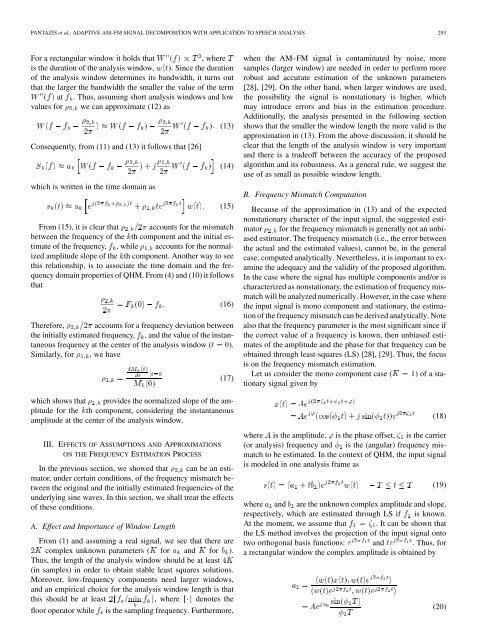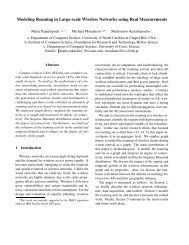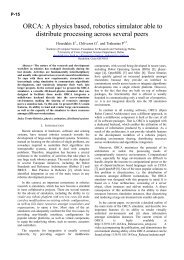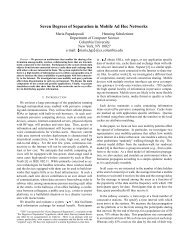Adaptive AM–FM Signal Decomposition With Application to ... - ICS
Adaptive AM–FM Signal Decomposition With Application to ... - ICS
Adaptive AM–FM Signal Decomposition With Application to ... - ICS
You also want an ePaper? Increase the reach of your titles
YUMPU automatically turns print PDFs into web optimized ePapers that Google loves.
PANTAZIS et al.: ADAPTIVE <strong>AM–FM</strong> SIGNAL DECOMPOSITION WITH APPLICATION TO SPEECH ANALYSIS 293<br />
For a rectangular window it holds that<br />
, where<br />
is the duration of the analysis window, . Since the duration<br />
of the analysis window determines its bandwidth, it turns out<br />
that the larger the bandwidth the smaller the value of the term<br />
at . Thus, assuming short analysis windows and low<br />
values for we can approximate (12) as<br />
Consequently, from (11) and (13) it follows that [26]<br />
which is written in the time domain as<br />
(13)<br />
(14)<br />
(15)<br />
From (15), it is clear that accounts for the mismatch<br />
between the frequency of the th component and the initial estimate<br />
of the frequency, , while accounts for the normalized<br />
amplitude slope of the th component. Another way <strong>to</strong> see<br />
this relationship, is <strong>to</strong> associate the time domain and the frequency<br />
domain properties of QHM. From (4) and (10) it follows<br />
that<br />
(16)<br />
Therefore, accounts for a frequency deviation between<br />
the initially estimated frequency, , and the value of the instantaneous<br />
frequency at the center of the analysis window ( ).<br />
Similarly, for ,wehave<br />
(17)<br />
which shows that provides the normalized slope of the amplitude<br />
for the th component, considering the instantaneous<br />
amplitude at the center of the analysis window.<br />
III. EFFECTS OF ASSUMPTIONS AND APPROXIMATIONS<br />
ON THE FREQUENCY ESTIMATION PROCESS<br />
In the previous section, we showed that can be an estima<strong>to</strong>r,<br />
under certain conditions, of the frequency mismatch between<br />
the original and the initially estimated frequencies of the<br />
underlying sine waves. In this section, we shall treat the effects<br />
of these conditions.<br />
A. Effect and Importance of Window Length<br />
From (1) and assuming a real signal, we see that there are<br />
complex unknown parameters ( for and for ).<br />
Thus, the length of the analysis window should be at least<br />
(in samples) in order <strong>to</strong> obtain stable least squares solutions.<br />
Moreover, low-frequency components need larger windows,<br />
and an empirical choice for the analysis window length is that<br />
this should be at least , where denotes the<br />
floor opera<strong>to</strong>r while is the sampling frequency. Furthermore,<br />
when the <strong>AM–FM</strong> signal is contaminated by noise, more<br />
samples (larger window) are needed in order <strong>to</strong> perform more<br />
robust and accurate estimation of the unknown parameters<br />
[28], [29]. On the other hand, when larger windows are used,<br />
the possibility the signal is nonstationary is higher, which<br />
may introduce errors and bias in the estimation procedure.<br />
Additionally, the analysis presented in the following section<br />
shows that the smaller the window length the more valid is the<br />
approximation in (13). From the above discussion, it should be<br />
clear that the length of the analysis window is very important<br />
and there is a tradeoff between the accuracy of the proposed<br />
algorithm and its robustness. As a general rule, we suggest the<br />
use of as small as possible window length.<br />
B. Frequency Mismatch Computation<br />
Because of the approximation in (13) and of the expected<br />
nonstationary character of the input signal, the suggested estima<strong>to</strong>r<br />
for the frequency mismatch is generally not an unbiased<br />
estima<strong>to</strong>r. The frequency mismatch (i.e., the error between<br />
the actual and the estimated values), cannot be, in the general<br />
case, computed analytically. Nevertheless, it is important <strong>to</strong> examine<br />
the adequacy and the validity of the proposed algorithm.<br />
In the case where the signal has multiple components and/or is<br />
characterized as nonstationary, the estimation of frequency mismatch<br />
will be analyzed numerically. However, in the case where<br />
the input signal is mono component and stationary, the estimation<br />
of the frequency mismatch can be derived analytically. Note<br />
also that the frequency parameter is the most significant since if<br />
the correct value of a frequency is known, then unbiased estimates<br />
of the amplitude and the phase for that frequency can be<br />
obtained through least-squares (LS) [28], [29]. Thus, the focus<br />
is on the frequency mismatch estimation.<br />
Let us consider the mono component case ( ) of a stationary<br />
signal given by<br />
(18)<br />
where is the amplitude, is the phase offset, is the carrier<br />
(or analysis) frequency and is the (angular) frequency mismatch<br />
<strong>to</strong> be estimated. In the context of QHM, the input signal<br />
is modeled in one analysis frame as<br />
(19)<br />
where and are the unknown complex amplitude and slope,<br />
respectively, which are estimated through LS if is known.<br />
At the moment, we assume that . It can be shown that<br />
the LS method involves the projection of the input signal on<strong>to</strong><br />
two orthogonal basis functions: and . Thus, for<br />
a rectangular window the complex amplitude is obtained by<br />
(20)
















